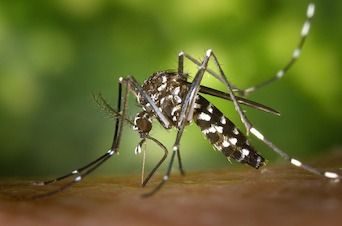Researchers Identify Venereal Transmission of Zika Virus in Mosquitoes
Aedes aegypti mosquitoes can transmit Zika virus during mating, potentially contributing to its maintenance and spread in nature.

Zika virus (ZIKV), an arbovirus, has swept rapidly across the Pacific and tropical America for the past several years. Human ZIKV infections typically occur through the bite of Aedes mosquitoes, primarily Aedes aegypti, and cause serious disorders such as microencephaly, making the virus a major public health issue. According to several recent studies, ZIKV can also spread between humans.
In addition to mosquito bites and inter-human transmission, ZIKV can also spread between mosquitoes, as evidenced by natural ZIKV infections in male Aedes mosquitoes in Africa and South America. Such modes of transmission partially explain how ZIKV is spread and maintained in nature. Overall, however, it remains incompletely understood how the virus is maintained in Africa and Asia and how it spread so rapidly in the western hemisphere.
To further explore ZIKV transmission, a research team recently examined whether the virus could undergo venereal transmission between A aegypti mosquitoes. The results were published recently in Parasites and Vectors.
REALTED:
- Zika Virus—Talking Points for Veterinarians
- Brazilian Monkeys Test Positive for Zika
Analysis
Researchers tested ZIKV venereal transmission in two populations of Brazilian A aegypti mosquitoes: (1) Urca from the coastal city of Rio de Janeiro and (2) Goiânia from an inland region of Brazil.
Viral Challenge of Female Mosquitoes
First, virgin female mosquitoes from each population were challenged orally with 1 of 2 ZIKV strains, Rio-U1 or PE243. Groups of these mosquitoes were euthanized 10 and 14 days postinfection, respectively, to determine infection rates. Infection rates ranged from 46% to 70% across populations and ZIKV strains, with PE243 having the lower infection rate.
Females not euthanized freely mated with virgin, uninfected male mosquitoes for either 30 hours without food or 5 days with food. The female:male ratio was either 1:1 or 2:1, and mosquitoes were matched according to population, age, and generation. After each mating period, mosquitoes were euthanized to determine female insemination and male venereal transmission rates.
Across populations, insemination rates were higher after 5 days than after 30 hours of mating (100% vs. 50%—90%). Venereal transmission occurred with Rio-U1, but not PE243; the male venereal transmission rate of Rio-U1 was higher in the Goiânia population than in the Urca population (33% vs. 0.9%).
Researchers attributed the variable insemination and venereal transmission rates to all of the females not mating with the males, particularly during the 30-hour mating period.
Viral Challenge of Male Mosquitoes
Next, virgin male mosquitoes were intrathoracically inoculated with the Rio-U1 strain. At 10 and 14 days postinfection, the males freely mated with females for 30 hours without food; the male-to-female ratio was 1:2. The mosquitoes were then euthanized to determine male infection and female venereal transmission rates.
Male infection rates were higher at 14 days than 10 days postinfection (98% versus 88%). Venereal transmission was detected only at 14 days postinfection, with 50% of females being infected with the virus at this time point.
Genome Sequencing
To determine whether the ZIKV underwent genetic changes during venereal transmission, the researchers compared the genomes of the virus used for the oral challenge and the virus extracted from females that were infected via venereal transmission. No genetic changes were observed.
Conclusions
The researchers concluded that ZIKV can undergo venereal transmission between A aegypti mosquitoes, demonstrating another way that the virus is maintained and spread in nature.
Dr. JoAnna Pendergrass received her Doctor of Veterinary Medicine degree from the Virginia-Maryland College of Veterinary Medicine. Following veterinary school, she completed a postdoctoral fellowship at Emory University’s Yerkes National Primate Research Center. Dr. Pendergrass is the founder and owner of JPen Communications, a medical communications company.